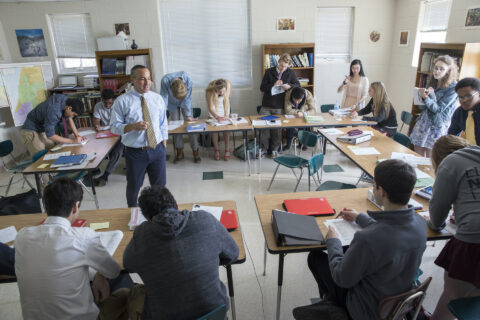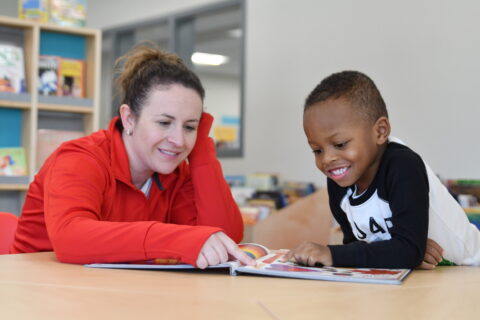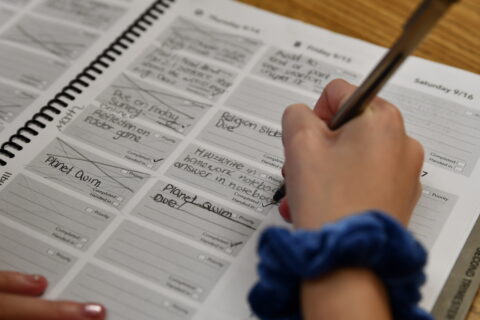By Amanda Freeman and Phyllis Robinson
Editor’s Note: This article was originally published in Volume 2 of “Think Differently and Deeply” (2015)
Biology and History. Two high school courses that seem very disparate from one another. One is all about microscopes and critters, while the other is all about dates and battles. Or at least that’s what conventional wisdom would have you believe. But when teachers at St. Andrew’s consider these courses, we find that we have more in common than you might think. While the subject matter is very different, a common thread between them is memory. How can we help students learn the facts and concepts that exist in each course both for and beyond the summative test or project?
We can think of memory as creating pegs in our students’ brains on which they hang the specific pieces of information that they read or discover. The real trick is for the students to retrieve what they have learned; in fact, the human brain can easily learn a lot of material very quickly – it’s the retrieval that’s so challenging. So how do we help our students become more capable retrievers? For us it began by looking at the research, in particular, “Make It Stick: The Science of Successful Learning.” Memory, like all brain functions, is not isolated to one region of the brain—and without it, learning does not happen. What follows is how we have translated research on memory to our respective disciplines, both at the Advanced Placement and non- AP levels.
Illusion of Learning
For years we promised students that if they would just review their active reading highlights or notes, they would succeed and demonstrate mastery. But research shows how misguided that is, because familiarity with material tends to result in the illusion that you have learned it. Research shows that when students have to pull information out of their brains, they remember material better than if they re-read the information. So now in biology, our students interact with the material in order to make it stick better. They build electronic flashcards using Quizlet for vocabulary recall, orally explain diagrams to their family members, quiz each other, rewrite their notes in a novel format, or use their notes packet to generate review sheets. Such strategies cross-over into history as well. Students in history class “self-test” by writing out essential names, dates, and ideas on a blank sheet of paper without any reference to their books or notes so that they can see how much they remember. Then they go back with their text open to fill in the gaps. These active retrieval strategies that are designed to be “deliberately difficult” are so much more than simply, and passively, “looking over their notes.”
Priming the Brain for Learning
Research shows that when students try to pull information from their brain before they learn it, they will remember it better when they have learned it. For example, students were asked “What made the French Revolution revolutionary?” before they had read the chapter. They had to generate information about the movements leading up to the French Revolution, based on their prior knowledge, and predict why it was such a game changer. Even if they got the wrong answers, which they probably should, having not studied the French Revolution very much, they were priming their brains to be aware of incoming information. In biology class, students are asked to predict what will happen next, be it in a metabolic pathway diagram or by predicting the effect of doubling the volume of yeast in a fermentation experiment. All of these in-class strategies keep students engaged in the learning process and have been shown to help our students retain what we want them to remember better.
Assessment
Research shows that frequent low-stakes or no stakes formative assessments help students recall information more effectively than almost any other study technique. After learning about DNA replication, for example, students close their notes and take a 3-question mini-quiz on what they just learned. Or on Fridays we might have a quiz that could be on any material we have studied so far this year. Since the stakes are low, wrong answers simply alert a student that she or he needs to focus more on that area, but the grade does not torpedo a student’s average. It also alerts us to where we might need to focus additional teaching. Research shows that better learning happens when students frequently engage in low-stakes quizzing because they have a better sense of what they know and don’t know due to the retrieval practice. Also the act of retrieval helps students memorize the material for future use, with multiple “spaced” attempts at this helping even more.
Success Stories
In biology, students spend considerable time learning about various phyla (groups) of animals in the Animal Kingdom. A lot of vocabulary and a lack of familiarity with the huge variety of living creatures in the world makes this a difficult topic for ninth graders. To help students keep their memory pegs clean and connected, they are encouraged to make concept maps for review. They are provided with vocabulary words in large type. Students cut these out and arrange them to reflect terms and concepts that are unique to each animal group, and then tape them onto large sheets of construction paper in a way that makes sense to them. Finally, they write in definitions, additional terms or ideas, and helpful memory tips. The whole process is their review, and what they create is essentially a review sheet. In fact, a student really won’t learn well from just looking at another student’s concept map—it’s the making of the map that helps a student figure out what they know and what they still need to learn. The first student who did this many years ago went from earning Cs on tests to earning As.
In history, research recommends manipulating course content out of sequence in some way in order to “make it stick.” My first action was to try to attack the summer reading in that way; students had read the first volume of the Norton History of Modern Europe on the Renaissance and Reformation. Students were assigned a country and had to follow that country throughout the book and tell the story of that country in the period of the Renaissance and Reformation.
The next step was to have students create an actual timeline that runs around the walls of our classroom. The country that the students had been assigned for their presentation on the summer reading was the country they would have to represent on the timeline. They came up with the idea of each country being a separate color. The timeline serves a multitude of purposes. Ideally, when they are taking the AP exam they will be able to shut their eyes and imagine where events are on the timeline. Having each country be a different color allows for students to see patterns on the timeline and, again, see and speak the narrative of that country. Finally, the action of deciding what goes on the timeline gives rise to great conversation and thinking. By associating a memory with a specific place in the room, students were creating memory palaces they could use to store this information. The novelty, choice and personal buy-in of this activity also deepened student engagement, which aided their learning.
The Teacher Researcher
Students get the novel experience of watching us be happily immersed doing something we routinely ask them to do—research. This is a topic fundamental to both our subjects. In our work on memory, as good researchers do, we try something, observe, reflect on what worked and what didn’t, tweak things, and try again. We model good research practice with, in front of, and for our students.
Conclusion
What’s our take-away message? We intentionally apply research about memory in our classroom teaching. In addition, we share it with the students so that they can use those strategies to retrieve information and be more successful. Students in A.P. European History or Biology may never take another Western Civilization or Life Science course in their lives, but it’s our goal that they remember these classes and what they learned about the world around them. Applying this research is a winning strategy for teachers on a more personal level as well. Why did we get into this profession? We love working with young people, but we also love our content and crave the opportunity to share the big ideas and the details. Translating educational neuroscience into the classroom gives us more opportunities to share our passions in a real and lasting way with our students.
We all win.
Phyllis Robinson teaches Biology at St. Andrew’s Episcopal School in Potomac and is a faculty facilitator for The CTTL. Amanda Freeman a former History teacher at St. Andrew’s and was a CTTL Teacher Research Fellow in 2014-2015.
Much of the memory research in this piece is taken from Peter Brown, Mark McDaniel and Henry Roediger III’s “Make It Stick: The Science of Successful Learning.”




